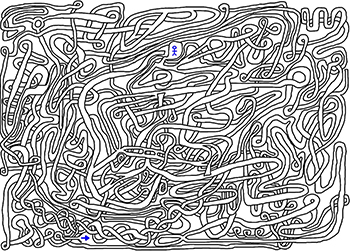- Crossword-Solving Neural Networks — Hill describes recent progress in learning-based AI systems in terms of behaviourism and cognitivism: two movements in psychology that effect how one views learning and education. Behaviourism, as the name implies, looks at behaviour without looking at what the brain and neurons are doing, while cognitivism looks at the mental processes that underlie behaviour. Deep learning systems like the one built by Hill and his colleagues reflect a cognitivist approach, but for a system to have something approaching human intelligence, it would have to have a little of both. “Our system can’t go too far beyond the dictionary data on which it was trained, but the ways in which it can are interesting, and make it a surprisingly robust question and answer system – and quite good at solving crossword puzzles,” said Hill. While it was not built with the purpose of solving crossword puzzles, the researchers found that it actually performed better than commercially-available products that are specifically engineered for the task.
- Mathematical Foundations for Social Computing (PDF) — collection of pointers to existing research in social computing and some open challenges for work to be done. Consider situations where a highly structured decision must be made. Some examples are making budgets, assigning water resources, and setting tax rates. […] One promising candidate is “Knapsack Voting.” […] This captures most budgeting processes — the set of chosen budget items must fit under a spending limit, while maximizing societal value. Goel et al. prove that asking users to compare projects in terms of “value for money” or asking them to choose an entire budget results in provably better properties than using the more traditional approaches of approval or rank-choice voting.
- Power, Minimal Detectable Effect, and Bucket Size Estimation in A/B Tests (Twitter) — This post describes how Twitter’s A/B testing framework, DDG, addresses one of the most common questions we hear from experimenters, product managers, and engineers: how many users do we need to sample in order to run an informative experiment?
- Intelligence-Augmented Rat Cyborgs in Maze Solving (PLoS) — We compare the performance of maze solving by computer, by individual rats, and by computer-aided rats (i.e. rat cyborgs). They were asked to find their way from a constant entrance to a constant exit in 14 diverse mazes. Performance of maze solving was measured by steps, coverage rates, and time spent. The experimental results with six rats and their intelligence-augmented rat cyborgs show that rat cyborgs have the best performance in escaping from mazes. These results provide a proof-of-principle demonstration for cyborg intelligence. In addition, our novel cyborg intelligent system (rat cyborg) has great potential in various applications, such as search and rescue in complex terrains.
"data science" entries


Four short links: 10 March 2016
Cognitivist and Behaviourist AI, Math and Social Computing, A/B Testing Stats, and Rat Cyborgs are Smarter


Four short links: 9 March 2016
Surveillance Capitalism, Spark in Jupyter, Spoofing Fingerprints, and Distributing SSH Keys
- The Secrets of Surveillance Capitalism — The assault on behavioral data is so sweeping that it can no longer be circumscribed by the concept of privacy and its contests. […] First, the push for more users and more channels, services, devices, places, and spaces is imperative for access to an ever-expanding range of behavioral surplus. Users are the human nature-al resource that provides this free raw material. Second, the application of machine learning, artificial intelligence, and data science for continuous algorithmic improvement constitutes an immensely expensive, sophisticated, and exclusive 21st century “means of production.” Third, the new manufacturing process converts behavioral surplus into prediction products designed to predict behavior now and soon. Fourth, these prediction products are sold into a new kind of meta-market that trades exclusively in future behavior. The better (more predictive) the product, the lower the risks for buyers, and the greater the volume of sales. Surveillance capitalism’s profits derive primarily, if not entirely, from such markets for future behavior. (via Simon St Laurent)
- Thunder — Spark-driven analysis from Jupyter notebooks (open source).
- Hacking Mobile Phones Using 2D-Printed Fingerprints (PDF) — equipment costs less than $450, and all you need is a photo of the fingerprint. (like those of government employees stolen en masse last year)
- SSHKeyDistribut0r (Github) — A tool to automate key distribution with user authorization […] for sysop teams.

Using Apache Spark to predict attack vectors among billions of users and trillions of events
The O’Reilly Data Show podcast: Fang Yu on data science in security, unsupervised learning, and Apache Spark.
Subscribe to the O’Reilly Data Show Podcast to explore the opportunities and techniques driving big data and data science: Stitcher, TuneIn, iTunes, SoundCloud, RSS.
In this episode of the O’Reilly Data Show, I spoke with Fang Yu, co-founder and CTO of DataVisor. We discussed her days as a researcher at Microsoft, the application of data science and distributed computing to security, and hiring and training data scientists and engineers for the security domain.
DataVisor is a startup that uses data science and big data to detect fraud and malicious users across many different application domains in the U.S. and China. Founded by security researchers from Microsoft, the startup has developed large-scale unsupervised algorithms on top of Apache Spark, to (as Yu notes in our chat) “predict attack vectors early among billions of users and trillions of events.”
Several years ago, I found myself immersed in the security space and at that time tools that employed machine learning and big data were still rare. More recently, with the rise of tools like Apache Spark and Apache Kafka, I’m starting to come across many more security professionals who incorporate large-scale machine learning and distributed systems into their software platforms and consulting practices.

Building a business that combines human experts and data science
The O’Reilly Data Show podcast: Eric Colson on algorithms, human computation, and building data science teams.
Subscribe to the O’Reilly Data Show Podcast to explore the opportunities and techniques driving big data and data science.
In this episode of the O’Reilly Data Show, I spoke with Eric Colson, chief algorithms officer at Stitch Fix, and former VP of data science and engineering at Netflix. We talked about building and deploying mission-critical, human-in-the-loop systems for consumer Internet companies. Knowing that many companies are grappling with incorporating data science, I also asked Colson to share his experiences building, managing, and nurturing, large data science teams at both Netflix and Stitch Fix.
Augmented systems: “Active learning,” “human-in-the-loop,” and “human computation”
We use the term ‘human computation’ at Stitch Fix. We have a team dedicated to human computation. It’s a little bit coarse to say it that way because we do have more than 2,000 stylists, and these are very much human beings that are very passionate about fashion styling. What we can do is, we can abstract their talent into—you can think of it like an API; there’s certain tasks that only a human can do or we’re going to fail if we try this with machines, so we almost have programmatic access to human talent. We are allowed to route certain tasks to them, things that we could never get done with machines. … We have some of our own proprietary software that blends together two resources: machine learning and expert human judgment. The way I talk about it is, we have an algorithm that’s distributed across the resources. It’s a single algorithm, but it does some of the work through machine resources, and other parts of the work get done through humans.

Is 2016 the year you let robots manage your money?
The O’Reilly Data Show podcast: Vasant Dhar on the race to build “big data machines” in financial investing.
Subscribe to the O’Reilly Data Show Podcast to explore the opportunities and techniques driving big data and data science.
In this episode of the O’Reilly Data Show, I sat down with Vasant Dhar, a professor at the Stern School of Business and Center for Data Science at NYU, founder of SCT Capital Management, and editor-in-chief of the Big Data Journal (full disclosure: I’m a member of the editorial board). We talked about the early days of AI and data mining, and recent applications of data science to financial investing and other domains.
Dhar’s first steps in applying machine learning to finance
I joke with people, I say, ‘When I first started looking at finance, the only thing I knew was that prices go up and down.’ It was only when I actually went to Morgan Stanley and took time off from academia that I learned about finance and financial markets. … What I really did in that initial experiment is I took all the trades, I appended them with information about the state of the market at the time, and then I cranked it through a genetic algorithm and a tree induction algorithm. … When I took it to the meeting, it generated a lot of really interesting discussion. … Of course, it took several months before we actually finally found the reasons for why I was observing what I was observing.

Investing in big data technologies
The O’Reilly Data Show podcast: A fireside chat with Ben Horowitz, plus Reynold Xin on the rise of Apache Spark in China.
Subscribe to the O’Reilly Data Show Podcast to explore the opportunities and techniques driving big data and data science.
In this special holiday episode of the O’Reilly Data Show, I look back at two conversations I had earlier this year at the Spark Summit in San Francisco. The first segment is an on-stage fireside chat with Ben Horowitz, co-founder of Andreessen Horowitz and author of The Hard Thing About Hard Things.
In the second segment, Reynold Xin, one of the architects of Apache Spark, explains the rise of Apache Spark in China.
Related resources:
- State of Spark, and where it is going in 2016: a Strata + Hadoop World San Jose presentation by Apache Spark architects, Reynold Xin and Patrick Wendell.
- Dates for Spark Summit 2016 conferences are now available.
- Learning Spark
- Real-time data applications

Patrick Wendell on Spark’s roadmap, Spark R API, and deep learning on the horizon
The O'Reilly Radar Podcast: A special holiday cross-over of the O'Reilly Data Show Podcast.
Subscribe to the O’Reilly Radar Podcast to track the technologies and people that will shape our world in the years to come.
In this special holiday episode of the Radar Podcast, we’re featuring a cross-over of the O’Reilly Data Show Podcast, which you can find on iTunes, Stitcher, TuneIn, or SoundCloud. O’Reilly’s Ben Lorica hosts that podcast, and in this episode, he chats with Apache Spark release manager and Databricks co-founder Patrick Wendell about the roadmap of Spark and where it’s headed, and interesting applications he’s seeing in the growing Spark ecosystem.
Here are some highlights from their chat:
We were really trying to solve research problems, so we were trying to work with the early users of Spark, getting feedback on what issues it had and what types of problems they were trying to solve with Spark, and then use that to influence the roadmap. It was definitely a more informal process, but from the very beginning, we were expressly user driven in the way we thought about building Spark, which is quite different than a lot of other open source projects. … From the beginning, we were focused on empowering other people and building platforms for other developers.
One of the early users was Conviva, a company that does analytics for real-time video distribution. They were a very early user of Spark, they continue to use it today, and a lot of their feedback was incorporated into our roadmap, especially around the types of APIs they wanted to have that would make data processing really simple for them, and of course, performance was a big issue for them very early on because in the business of optimizing real-time video streams, you want to be able to react really quickly when conditions change. … Early on, things like latency and performance were pretty important.

Building a scalable platform for streaming updates and analytics
The O’Reilly Data Show podcast: Evan Chan on the early days of Spark+Cassandra, FiloDB, and cloud computing.
Subscribe to the O’Reilly Data Show Podcast to explore the opportunities and techniques driving big data and data science.
In this episode of the O’Reilly Data Show, I sit down with Evan Chan, distinguished engineer at Tuplejump. We talk about the early days of Spark (particularly his contributions to Spark/Cassandra integration), his interesting new open source project (FiloDB), and recent trends in cloud computing.
Bringing Apache Spark & Apache Cassandra together
Datastax credits me with inspiring them to bring Spark into Cassandra … I think they’re very generous about that. I think I was one of the first folks to talk about the possibility of bringing Cassandra and Spark together. The vision that I saw was that Cassandra was really good for real-time updates, but what if we’re able to do more analytical queries on it? Then you could combine, basically, a platform that is really good for real-time updates with analytics.

Jai Ranganathan on architecting big data applications in the cloud
The O’Reilly Data Show podcast: The Hadoop ecosystem, the recent surge in interest in all things real time, and developments in hardware.
Subscribe to the O’Reilly Data Show Podcast to explore the opportunities and techniques driving big data and data science.
Given the quick pace of innovation in the data ecosystem, we like to take a step back from the details of individual components, architecture, and applications, in order to take a wider view of the landscape of big data. This allows us to evaluate the progress of technology and infrastructure along the way, shifting our attention from the details of individual components like Spark and Kafka, to larger trends.
Some of the larger trends we’ve been exploring include the capabilities of distributed machine learning and the tradeoffs and design decisions involved in cloud architecture and stream processing.
In this episode of the O’Reilly Data Show, I sat down with Jai Ranganathan, senior director of product management at Cloudera. We talked about the trends in the Hadoop ecosystem, cloud computing, the recent surge in interest in all things real time, and hardware trends:
Large-scale machine learning
This sounds a bit like this should already exist in really good form right now, but one of the things that I’m really interested in is expanding the set of capabilities for distributed machine learning. While there are systems out there today that do do this, I think relative to what you can experience from a singular environment learning scikit-learn or R, the set of things you can do in a distributed fashion is limited. … It’s not easy to distribute various algorithms and model-building techniques. I think there is still a lot of work for us to do to improve that experience. … And I do want to have good open source options like MLlib. MLlib may be the right answer. I would be perfectly happy if that’s the final answer, but we do need systems just to provide the kind of depth that you typically are used to in the singular environment. That’s just a matter of time and investment because these are non-trivial problems, but they are things that people are working on.







